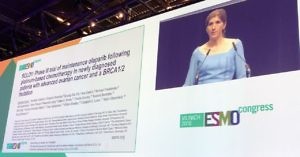Why are the SOLO1 data so compelling?

Dr Moore at ESMO18
At the recent European Society of Medical Oncology (ESMO18) Congress in Munich, arguably the data of the meeting – if the audience reaction is anything to go by – were the results from the phase 3 SOLO1 trial that were presented by Dr Kathleen Moore (right).
The results were simultaneously published in The New England Journal of Medicine in an article entitled: “Maintenance Olaparib in Patients with Newly Diagnosed Advanced Ovarian Cancer” (Link).
As Moore and colleagues note in the abstract:
“After a median follow-up of 41 months, the risk of disease progression or death was 70% lower with olaparib than with placebo (Kaplan–Meier estimate of the rate of freedom from disease progression and from death at 3 years, 60% vs. 27%; hazard ratio for disease progression or death, 0.30; 95% confidence interval, 0.23 to 0.41; P < 0.001).”
Dr Moore is an Associate Professor of gynecologic oncology and the Jim and Christy Everest Endowed Chair in Cancer Research at the University of Oklahoma Stephenson Cancer Center. She kindly spoke to BSB after her presentation in the Presidential Symposium.
In addition to Dr Moore’s personal commentary on what these results mean for women with ovarian cancer, we also have some additional insights on what this data may mean for other players in the PARP space such as Tesaro and Clovis.
To learn more from our latest assessment and get a heads up on our oncology insights, subscribers can log-in or you can click to gain access to BSB Premium Content.
This content is restricted to subscribers